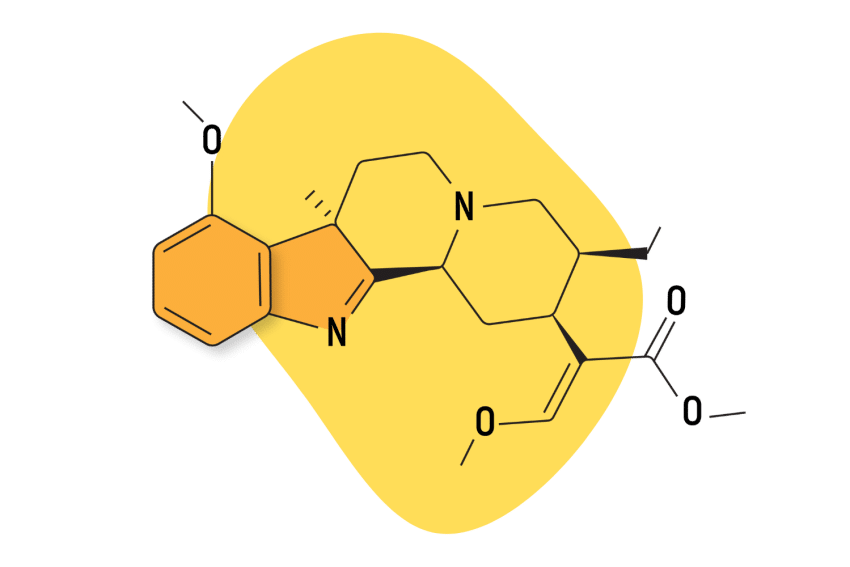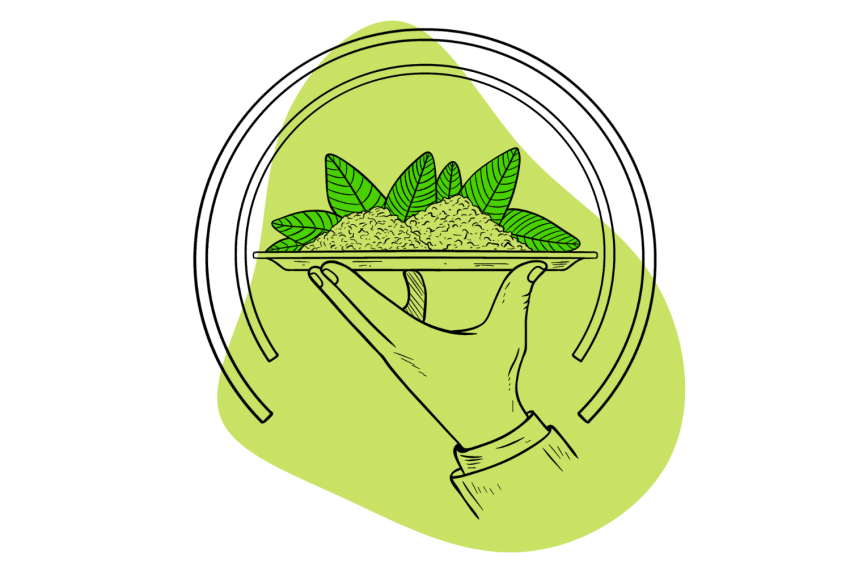How to Take Kratom: The Good, The Bad, & The Ugly
There’s no lack of creativity when it comes to taking kratom — but that doesn’t mean every option is a good one.

There are many ways to enjoy kratom (Mitragyna speciosa) — some optimize for efficiency; others are designed to avoid the bitter, grassy taste of the dried leaves.
There are also a few methods that really shouldn’t be used at all.
Here are 10 ways to take kratom (for better or for worse):
A. Best Ways to Take Kratom
There are many ways to take kratom; what works for one person won’t work for the next, so take this list with a grain of salt.
1. Kratom Tea
Kratom tea is our favorite way to take kratom. It isn’t the strongest (that distinction goes to the toss’n’wash method or other raw powder forms) — but it offers the best blend of potency, ease of preparation, and taste.
There are 4 ways to make a nice cup of kratom tea:
- Brew crushed leaves in a tea bag
- Use pre-made kratom tea bags
- Brew powder as tea and strain
- Mix kratom powder to another tea

Pre-made anything — including kratom tea bags — will cost more, but you’re paying for convenience. You can buy reusable tea bags and then fill them with kratom leaves. Or heat water and add the powder. Personally, I prefer to brew a strong cup of black or green tea and add the powder and some lemon juice (the tea goes down much easier).
To make a kratom tea, simply weigh or measure your dose and steep in some boiling water for about 5 minutes. The longer you wait, the stronger your kratom tea will get.
Alternatively, you can re-steep your tea several times to get the most out of your kratom leaf.
2. Kratom Capsules
Capsules are pretty self-explanatory — gelatin capsules willed with kratom powder.
There are several capsule sizes, and they’ll contain different amounts of kratom. The smallest ones contain around 0.1 grams of powder (100 mg), while the biggest capsules can carry up to 0.8 mg or 1 gram.
While capsules are arguably the easiest way to take kratom, there are downsides.
First, it’s difficult to control the exact amount you are taking. If your capsules contain 0.5 grams, for example, you won’t be able to take 4.8 grams. You might have to take more than your ideal dose — something that’s best to avoid — or take a less effective dose.
Capsules are also more expensive than loose powder due to the extra steps needed to make them. Many people prefer to buy in bulk and save money. However, you can always fill capsules yourself if you prefer using them but want to avoid the high cost.
Additionally, if you have trouble swallowing pills, this might not be the way to go because you usually need to take several kratom capsules for a single dose. This can be a big turnoff, even for those who can swallow pills.

3. The Toss’N’Wash Method
This method offers the best bang for your buck in terms of potency — but is also, by far, the most uncomfortable method of taking kratom. This method is designed to get your horrible, bitter, chalky kratom powder into your body as quickly as possible. It’s like quickly ripping off a Bandaid quickly — the discomfort is significant, but over in an instant.
This method is essentially dry scooping. You take the kratom dose, dump it into your mouth, and swallow it with a drink.

It tastes horrible and can be gross since the powder wants to stick to your teeth, but it’s quick, easy, and gets the job done. This is a great alternative if you’re out somewhere and can’t make tea. It’s also a better option than tea and capsules if you normally take more than about 5 grams of kratom powder at a time.
Words of wisdom here — don’t try to toss’n’wash if you’re new to kratom.
Let yourself adjust to the taste before you assault your mouth. And if you have issues with texture or swallowing, this might not be for you.
B. “Good” Methods of Taking Kratom
These next two we rank as just “good” — they work, but there are clear downsides that make them less desirable or effective than the 3 methods outlined above.
4. Kratom Edibles
Kratom edibles don’t make it to the “favorites” list for 2 reasons — they’re very expensive and are more of a novelty than anything.
You can argue that they’re convenient — and they are — but they’re not better than capsules in this regard.
Dosing is more difficult and way less reliable than capsules. Additionally, edibles are more perishable than kratom powder, capsules, or teabags (gummies and chocolate melt, cookies get stale, etc.)
Edibles are fun and have a time and place, but they aren’t a great, cost-effective option for daily use.
5. Added to Drink or Food
Kratom can be added to recipes and drinks — the alkaloids can withstand a high level of heat, so as long as you’re quick about it (like heating spaghetti sauce or baking cookies), the kratom should be fine.

It’s easy to sprinkle a dose of kratom powder into a smoothie or on top of your salad or other food — just finish it all. You can also make a large batch of something and add multiple doses of kratom, but this requires math, diligence, making sure the power is evenly distributed, and dividing the final product right.
You can also mix liquid kratom extracts into teas, juices, smoothies, or other drinks. Using them alongside meals or snacks is also a good idea since they’ll help mask the bitter flavor of the extract.
6. Parachute
This one is a little weird — it requires wrapping a dose of kratom in toilet paper or tissue paper and then swallowing it with a drink. Think capsule wannabes.
This can be fantastic since it’s straightforward and quick. However, it can be a little messy if you take a lot of kratom, and some people might have trouble swallowing it.
Still, tuck this one into the back of your mind — I can almost guarantee it will come in handy someday.
7. Shots, Tictures, & Extracts
As nice as they can be, shots didn’t make it on either list for a few reasons — the main one being that they’re more dangerous.
A lot of the kratom shots available are made from mitragynine extract instead of the whole plant. This changes the overall effects since kratom’s alkaloids work together to give it power. This also makes them more likely to cause side effects and addiction.
There’s nothing wrong with shots, but be extra cautious and save them for special occasions.
Then, there are two types of kratom extracts to consider: tinctures and concentrated kratom extracts, which usually come as tablets or powder.
Extracts are much more potent than loose powder or capsules, so be precise when taking kratom this way.
Some companies sell kratom extract tablets, which make dosing more convenient. One tab contains anywhere from 50 to 100 mg of mitragynine and/or 7-hydroxymitragynine (the active ingredients in kratom).
Extract powder is a condensed version of the regular powder.
These products can be handy to have on hand — especially if you use kratom for pain relief — but don’t use them daily.
C. “Bad” Methods of Taking Kratom (We Do Not Recommend!)
Not only are these next three either very uncomfortable or simply a waste of kratom, but they’re also dangerous.
We gave you six other options; there’s no need to go down this road.

8. Smoking
Some people smoke kratom. Sometimes, they even recommend it. Unfortunately, this method is bad for your lungs and your wallet. You’ll literally burn through a lot of kratom and have nothing to show for it. The intense heat can destroy alkaloids; even if they survive, the impact won’t be the same as if you had taken it orally.
Which brings us to the next point.
9. Boofing
Boofing is a slang term used for putting drugs up your bum. If it sounds like a generally bad idea, good. You’re right. If you’re thinking how clever this could be, please get help. Seriously. You’re too desperate for a quick hit.
People do it because it gets the drug into the bloodstream very quickly. However, this is dangerous because, well, putting anything up there is risky. You open yourself up to injury and infection. Not fun. Plus, the effects could be way more intense than you wanted.
10. Snorting
Snorting could, in theory, work. But do me a favor and pour a tablespoon of water into a cup and add a tablespoon of kratom powder. Give it a good stir. Do you want that up in your sinus cavity?
There’s no way this will be comfortable or short-lived — it’s dangerous and can cause infections and other problems.

The #1 Worst Way to Take Kratom — Irresponsibly
Kratom is safe — as safe or safer than many other medications. But it’s not risk-free, and certain things amplify those risks. Here are three ways to make sure that doesn’t happen.
1. Don’t Mix It With Other Substances
Hands down, this is the worst thing you can do. Kratom’s adversaries love to point to the number of deaths kratom has caused (which isn’t many), but other substances are involved in almost every case. Opioids are the main culprit, but heroin, cocaine, amphetamines, and benzodiazepines are all too common. [1]
If the drug affects your central nervous system (either speeding it up, like meth, or slowing it down, like opioids), don’t use kratom with it.
Talk to your doctor if you think kratom could help you, but you’re taking a prescription drug. Never stop or adjust your prescription without your doctor’s consent.
2. Dose Wisely & Take Breaks
We won’t tell you not to use kratom recreationally. It can be a mild and safe enough way to have fun — as long as you stick to rule #1 (which also diminishes the recreational aspect). A cup of kratom tea can help you unwind or feel more upbeat and social before heading out.
The more significant risks probably come from daily use. It’s easy to build a tolerance, up your dose, and end up addicted. Kratom addiction is different from opioid addiction — it takes a much longer time to become dependent, and the withdrawal isn’t as severe — but it’s still unsafe and unpleasant. [2]
Use kratom as you would anything else. As needed, but limit how much you take and how often you take it. Don’t exceed a certain amount in a day (this varies from person to person), and don’t use it long-term — stop using it for a few days every week.
3. Only Buy from Reputable Sources
While you can find kratom all over, we recommend using some discretion. Contaminated kratom is less of an issue than it was when it first became popular, but don’t take chances. It still happens.
Kratom is federally unregulated in the US and many other places, which puts the consumer at risk since it’s sold without oversight.
However, we can manage on our own and keep ourselves safe as long as we know what to look for:
- Kratom that is lab-tested through a third-party
- Kratom that’s stored properly — sealed and away from heat, the sun, and strong odors.
- A shop that has plenty of positive reviews and knows about kratom
If a product isn’t lab-tested, there’s no proof of what’s in it. Sometimes, kratom is adulterated with other substances to make it seem more potent or is contaminated with mold or bacteria. [3]
A store that sells kratom should have a good understanding of what it is and how to use it. If these things aren’t in place, look elsewhere. Online kratom vendors are usually the best option since their prices are cheaper, the selection is better, and they specialize in it.

Will the Method Alter Kratom’s Effects?
Some methods will cause the kratom to kick in sooner or last longer, which might make it feel more potent. Powder is faster than capsules or edibles since those have to break down first. The effects don’t generally change much since that has more to do with dose and strain.
However, if you’re using a product — such as an edible or a liquid shot — made from extract, the effects will be more potent, more dangerous, and possibly different altogether [4].
As previously mentioned, some only contain mitragynine, kratom’s primary alkaloid. These will be good for energy but less effective for pain. And, similar to how cannabinoids work, kratom’s alkaloids work better together.
In order to get a handle on the effects, you need to understand the different strains and how dosage works.
Can the Method Increase the Risk of Side Effects?
Yes, but the flip side is also true — some methods could help reduce the risk.
Kratom’s side effects are tolerable and don’t last long, but tend to increase as the amount increases. The more you take, the more likely you will experience adverse effects and the more severe they’ll be.
Nausea, vomiting, headaches, constipation, fatigue, dehydration, and anxiety are the most prevalent. Kratom is also addictive, and we don’t know much about its long-term effects.
Some methods — like tea — can help reduce the risk of nausea, while others — such as shots or the toss and wash — could make it more likely.
Any of the three “horrible” methods will increase the risks significantly.
Because everyone is different, the best thing to do is experiment. If you feel unpleasant after taking kratom, lower your dose next time since that’s the more likely culprit, and try taking it differently. Chances are, you’ll find something that works.
To reduce the risks, regardless of the method you use, follow the above tips on responsible use.
How Dosage Impacts Kratom’s Effects
Proper kratom dosage is the #1 thing that impacts the effects. It can be hard to know how much kratom to take, but here are some helpful generalizations [5].
Smaller amounts (2-5 grams) of kratom are more energizing. It acts like a nootropic at this level, providing focus, a clear mind, stimulation, and a better mood.
Larger amounts (5-10 grams) are sedating and more helpful for pain and anxiety.
Start at the low end and work your way up. Kratom can take 30-60 minutes to kick in, so give it ample time before taking more.
How the Strain Impacts Kratom’s Effects
The strain you use will also change how it makes you feel. All kratom comes from the same plant — MItragyna speciosa — but the alkaloid content varies, causing subtle differences.
You’ll notice kratom comes in different strains, similar to marijuana, and each tends to have specific effects.
Here’s a rundown of what you can expect from each strain.

Red Vein Strains
Red vein kratom strains are higher in the alkaloid 7-hydroxymitragynine, known for its potent actions on the opioid receptors.
The best uses for red vein strains include:
- Managing intense or chronic pain
- Alleviating anxiety and stress
- Supporting better and deeper sleep
Popular red vein strains include:
- Red Borneo
- Red Bali
- Red Maeng Da

White Vein Strains
White strains are mainly known for their stimulating effects and are great for when you need a boost during a hard day at work or a long study session.
These usually have a high percentage of the alkaloid mitragynine, which acts on the adrenergic and dopamine systems.
The best uses for white vein strains include:
- Uplifting your mood
- Enhancing cognitive functions
- Reducing feelings of lethargy
Popular white vein strains include:
- White Borneo
- White Indo
- White Maeng Da

Green Vein Strains
Green-veined strains are the most balanced and, therefore, the most popular. They provide the full range of effects, just milder.
These strains are best for beginners as they are less likely to cause side effects. However, experienced users often prefer to have more control over the specific effects they get from their kratom.
The best uses for green vein strains include:
- Relieving mild to moderate pain
- Boosting mental energy
- Reducing stress
Popular green vein strains include:
- Green Indo
- Green Sumatra
- Green Thai

Yellow Vein Strains
Technically, yellow varieties are not an actual strain, as you can’t find them in nature. Yellow strains come from white strains and are the result of a particular way of processing them or are a mix of other strains.
Not every kratom vendor commercializes yellow strains, making them more challenging to find. You will probably find these strains as powder and capsules, but any type of extract is rare.
Yellow strains are similar to green varieties, making them beginner-friendly. If white strains are too potent, but you still want the nootropic benefits, you should try yellow kratom. They’re also great for reducing anxiety.
The best uses for yellow vein strains include:
- Improving focus
- Relieving pain
- Reducing anxiety
Popular yellow vein strains include:
- Yellow Sumatra
- Yellow Vietnam
- Yellow Maeng Da
Kratom FAQs
Here are some of the most common questions we get asked about kratom.
1. Is kratom legal?
Kratom is mostly legal in the US. Some states and cities have banned or regulated it, as have some countries. Check your local laws for the most up-to-date information.
2. Will kratom show up on a drug test?
Kratom will not appear on a standard drug test, but kratom’s four main indole alkaloids can show up on improved liquid-chromatographic–high-resolution mass-spectrometric (LC-HRMS) tests. However, considering its federal legal status and the specialized tests required, you’ll unlikely be tested for kratom.
3. What are kratom potentiators?
Some things will help boost kratom’s effects — these are called potentiators. Using them can help stretch your kratom, but they can also make side effects more likely. Only use them once in a while, and be extra careful if you’re on any medications since these can cause drug interactions.
Some common potentiators include lemon or grapefruit juice, turmeric, and black seed oil.
References
- Swogger, M. T., Smith, K. E., Garcia-Romeu, A., Grundmann, O., Veltri, C. A., Henningfield, J. E., & Busch, L. Y. (2022). Understanding kratom use: a guide for healthcare providers. Frontiers in pharmacology, 13, 801855.
- Henningfield, J. E., Chawarski, M. C., Garcia-Romeu, A., Grundmann, O., Harun, N., Hassan, Z., … & Huestis, M. A. (2023). Kratom withdrawal: Discussions and conclusions of a scientific expert forum. Drug and Alcohol Dependence Reports, 7.
- Ramanathan, S., León, F., Chear, N. J., Yusof, S. R., Murugaiyah, V., McMahon, L. R., & McCurdy, C. R. (2021). Kratom (Mitragyna speciosa Korth.): A description on the ethnobotany, alkaloid chemistry, and neuropharmacology. Studies in Natural Products Chemistry, 69, 195-225.
- Sharma, A., & McCurdy, C. R. (2021). Assessing the therapeutic potential and toxicity of Mitragyna speciosa in opioid use disorder. Expert opinion on drug metabolism & toxicology, 17(3), 255-257.
- Kruegel, A. C., & Grundmann, O. (2018). The medicinal chemistry and neuropharmacology of kratom: a preliminary discussion of a promising medicinal plant and analysis of its potential for abuse. Neuropharmacology, 134, 108-120.








